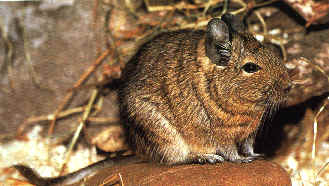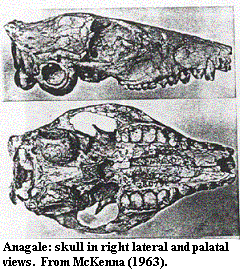
Total Group Glires
| Palaeos |  |
Glires |
| Vertebrates | Anagaloidea Total Group Glires |
| Page Back | Unit Home | Unit Dendrogram | Unit References | Taxon Index | Page Next |
| Unit Back | Vertebrates Home | Vertebrate References | Vertebrate Dendrograms | Glossary | Unit Next |
|
Abreviated Dendrogram
EUARCHONTOGLIRES |--ARCHONTA | `--ANAGALIDA (Total Group Glires) |--Anagaloidea | |--Anagalidae | `--Pseudictopidae `--Glires |--Lagomorpha `--RODENTIA |
Contents
Overview |
Taxa on This Page
 Anagalida : Total Group Glires
Anagalida : Total Group Glires
Range: from the Paleocene
Phylogeny: Euarchontoglires : Archonta + * : Anagaloidea + Glires.
Comment: Of two groups previously included under the Anagalida, Zalambdalestidae now considered a stem eutherian on cladistic and morphological grounds; Macroscelidea is included under the Afrotheria on molecular grounds. It's been suggested that Dinocerata belongs here, although the evidence is as controversal as for any hypothesis regarding the relationships of that bizarre yet charismatic group of early Tertiary mammals MAK120316
Image: a degu from Silke & Frank / Degus.
Links: Root Anagalida; Salles (English & French); Molecular Systematics; Classification Table; EEvvoolluuttiiee vvaann ddee PPrriimmaatteenn eenn ddee MM; Mammalian mitogenomic relationships and the root of the eutherian ...; Genera and species of Paleocene mammals - Part 2; Paleocene mammals of the world; Rabbits and Hares; Rodent Phylogeny and a Timescale for the Evolution of Glires- ... (a molecular study with reasonable results!); Synonyms of the Anagalida; Brief report; The interphotoreceptor retinoid binding protein gene in therian mammals; Usage Optimization of Unevenly Sampled Data through the ...; Molecular Systematics. ATW040118
Range: Paleocene to Late Oligocene of North America & Asia
Phylogeny: Anagalida::: Glires + *: Anagalidae + Pseudictopidae.
Links: Anagaloidea ATW021028.
 Anagalidae :
Anagale, Anagalopsis, Anaptogale, Diacronus, Eosigale, Hsiuannania,
Huaiyangal, Linnania, Palasiodon?, Qipania, Stenanagale, Yuodon?
Anagalidae :
Anagale, Anagalopsis, Anaptogale, Diacronus, Eosigale, Hsiuannania,
Huaiyangal, Linnania, Palasiodon?, Qipania, Stenanagale, Yuodon?
Range: Paleocene to Oligocene of Mongolia.
Phylogeny: Anagaloidea: Pseudictopidae + *.
 Characters:
skull small [C88]; dentary condyle well above tooth row [C88]; auditory bulla formed from fusion of tympanic and entotympanic [Mc63];
dentary coronoid process short & recurved [C88]; P3 large & molariform, but with low cusps and with
protocone tilted forward [Mc63]; P3-P4 metacones weakly developed [S68]; P4 lingually high, with tall, vertical
protocone [Mc63]; upper molars with paracone & metacone near buccal margin
[C88]; lower molar trigonid
formed largely from metaconid & protoconid, with small paraconid anterior
& merged with metaconid [Mc63]; m1 with continuous enamel rim in place
of hypoconid & entoconid [Mc63]; m2 & m3 with successively more
distinct and separated cusps [Mc63]; manus with large, fissured claws [Mc63];
tibia & fibula separate with marked spatium interosseum [S68]; pes with fissured?, distally spatulate unguals [Mc63]; probably diurnal,
fore-foot digger [Mc63].
Characters:
skull small [C88]; dentary condyle well above tooth row [C88]; auditory bulla formed from fusion of tympanic and entotympanic [Mc63];
dentary coronoid process short & recurved [C88]; P3 large & molariform, but with low cusps and with
protocone tilted forward [Mc63]; P3-P4 metacones weakly developed [S68]; P4 lingually high, with tall, vertical
protocone [Mc63]; upper molars with paracone & metacone near buccal margin
[C88]; lower molar trigonid
formed largely from metaconid & protoconid, with small paraconid anterior
& merged with metaconid [Mc63]; m1 with continuous enamel rim in place
of hypoconid & entoconid [Mc63]; m2 & m3 with successively more
distinct and separated cusps [Mc63]; manus with large, fissured claws [Mc63];
tibia & fibula separate with marked spatium interosseum [S68]; pes with fissured?, distally spatulate unguals [Mc63]; probably diurnal,
fore-foot digger [Mc63].
Notes: [Mc63] makes a very strong case against archontan affinity. In McKenna's view, the anagalids are late-surviving variants of the ancestral Asian proto-rabbit stock.
Links: Die Ordnung der Primaten- Halbaffen (reflects former associations with Archonta); 30 September, 1996.
References: Carroll (1988) [C88]; McKenna (1963) [Mc63]; Sulimski (1968) [S68]. ATW031023.
 Pseudictopidae : Allictops, Anictops, Cartictops, Haltictops, Paranictops, Pseudictops
Pseudictopidae : Allictops, Anictops, Cartictops, Haltictops, Paranictops, Pseudictops
Range: Late? Paleocene to Early Eocene of Central Asia & North America
Phylogeny: Anagaloidea: Anagalidae + *.
Characters: badger or fox-size [S68]; zygomatic arch full & slender badger or fox-size [S68]; dentary moderately long, thick and tall [S68]; symphysis extends to p2 [S68]; dental formula 3/3,1/1, 4/4, 3/3 [S68]; unique canines, large, with posterior cutting edge, accessory cusps & denticles (very odd-looking!) [S68]; p3 & p4 protoconid taller than metaconid [S68]; p4 very molariform [S68]; molars with thin, lobate crowns [C88]; trigon & trigonid cristae short & sharp [S68]; upper molars twice as wide as long [S68]; trigon extended far lingually [C88]; P3-M3 hypocone very small or absent [S68]; P3-P4 metacones weakly developed as in Anagalidae [S68]; trigonids twice as high as talonids [S68]; molar metaconids taller than protoconids [S68]; p3-m3 paraconids strongly reduced [S68]; paralophid short, steep & lower than metalophid [S68]; tibia & fibula separate, but without spatium interosseum distally [S68]; tibia & fibula longer & more slender than in Anagalidae [S68]; astragalar trochlea almost symmetrical [S68]; hind limb with 5 digits, plantigrade to digitigrade [S68]; metatarsals II-IV, long with III the longest [S68]; pedal unguals fissured & proximally enlarged (not distally spatulate) [S68].
Note: [1] Note that the talonid shows the same general diamond shape as in the Anagalidae, with the same reduced talonid cusps. The paraconid is similarly reduced, and the parastylid may be homologous to a similar structure in Anagale, although the latter is very worn in the photograph above. The rhomboid shape of the talonid is produced in part by the presence of a pronounced cristid obliqua (or, one supposes, lophid obliqua in this case), which is a fairly distinct character. The cristid obliqua is the "one-armed" loph that proceeds mesiolingually from the hypoconid. We use loph, rather than crista to indicate that this is a cutting edge of enamel on a base of dentine. The dentine wears faster than the enamel, keeping the ridge sharp. The structure labeled metalophid probably ought to be the protolophid using our standard nomenclature.
References: Carroll (1988) [C88]; Sulimski (1968) [S68]. ATW030430
| Page Back | Unit Home | Page Top | Page Next |
checked ATW040121